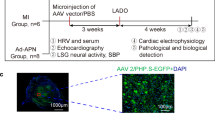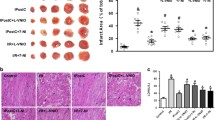Abstracts
Excessive sympathetic activation contributes to the progression of chronic heart failure. Reactive oxygen species in paraventricular nucleus (PVN) play an important role in the enhanced sympathetic outflow. This study was designed to determine whether superoxide dismutase 1 (SOD1) overexpression in the PVN attenuated the sympathetic activation and cardiac dysfunction in rats after an episode of myocardial infarction (MI). Adenoviral vectors containing human SOD1 (Ad-SOD) or null adenoviral vectors (Ad-null) were immediately microinjected into the PVN of rats with coronary artery ligation or sham operation. At the eighth week, the SOD1 protein level and activity in the PVN increased while the superoxide anions in the PVN decreased in Ad-SOD rats. The SOD1 overexpression in the PVN prevented the increases in left ventricular end-diastolic pressure and volume, and the decreases in ejection fraction and peak velocities of contraction in MI rats. In addition, there was an attenuation of renal sympathetic nerve activity, cardiac sympathetic afferent reflex and plasma norepinephrine level in MI rats. Furthermore, the SOD1 overexpression in the PVN reduced cardiomyocyte size, collagen deposition and the TUNEL-positive cardiomyocytes in MI rats. These results indicate that the SOD1 overexpression in the PVN attenuates the excessive sympathetic activation, myocardial remodeling, cardiomyocyte apoptosis and ventricular dysfunction in MI rats.





Similar content being viewed by others
References
Badoer E (2010) The role of the hypothalamic PVN in the regulation of renal sympathetic nerve activity and blood flow during hyperthermia and in heart failure. Am J Physiol Renal Physiol 298:F839–F846
Burmeister MA, Young CN, Braga VA, Butler SD, Sharma RV, Davisson RL (2011) In vivo bioluminescence imaging reveals redox-regulated activator protein-1 activation in paraventricular nucleus of mice with renovascular hypertension. Hypertension 57:289–297
Cohn JN, Levine TB, Olivari MT, Garberg V, Lura D, Francis GS, Simon AB, Rector T (1984) Plasma norepinephrine as a guide to prognosis in patients with chronic congestive heart failure. N Engl J Med 311:819–823
Coote JH (2005) A role for the paraventricular nucleus of the hypothalamus in the autonomic control of heart and kidney. Exp Physiol 90:169–173
Ding L, Dong L, Chen X, Zhang L, Xu X, Ferro A, Xu B (2009) Increased expression of integrin-linked kinase attenuates left ventricular remodeling and improves cardiac function after myocardial infarction. Circulation 120:764–773
Ding Y, Li YL, Zimmerman MC, Davisson RL, Schultz HD (2009) Role of CuZn superoxide dismutase on carotid body function in heart failure rabbits. Cardiovasc Res 81:678–685
Du YH, Chen AF (2007) A “love triangle” elicited by electrochemistry: complex interactions among cardiac sympathetic afferent, chemo-, and baroreflexes. J Appl Physiol 102:9–10
Duan YC, Xu B, Shi Z, Gao J, Zhang SJ, Wang W, Chen Q, Zhu GQ (2009) Nucleus of solitary tract mediates cardiac sympathetic afferent reflex in rats. Pflugers Arch 459:1–9
Dumasius V, Jameel M, Burhop J, Meng FJ, Welch LC, Mutlu GG, Factor P (2003) In vivo timing of onset of transgene expression following adenoviral-mediated gene transfer. Virology 308:243–249
Felder RB, Francis J, Weiss RM, Zhang ZH, Wei SG, Johnson AK (2001) Neurohumoral regulation in ischemia-induced heart failure. Role of the forebrain. Ann N Y Acad Sci 940:444–453
Felder RB, Yu Y, Zhang ZH, Wei SG (2009) Pharmacological treatment for heart failure: a view from the brain. Clin Pharmacol Ther 86:216–220
Floras JS (2009) Sympathetic nervous system activation in human heart failure: clinical implications of an updated model. J Am Coll Cardiol 54:375–385
Francis GS (1985) Neurohumoral mechanisms involved in congestive heart failure. Am J Cardiol 55:15A–21A
Francis J, Weiss RM, Wei SG, Johnson AK, Felder RB (2001) Progression of heart failure after myocardial infarction in the rat. Am J Physiol Regul Integr Comp Physiol 281:R1734–R1745
Fujimoto H, Taguchi J, Imai Y, Ayabe S, Hashimoto H, Kobayashi H, Ogasawara K, Aizawa T, Yamakado M, Nagai R, Ohno M (2008) Manganese superoxide dismutase polymorphism affects the oxidized low-density lipoprotein-induced apoptosis of macrophages and coronary artery disease. Eur Heart J 29:1267–1274
Gao L, Wang W, Li YL, Schultz HD, Liu D, Cornish KG, Zucker IH (2005) Simvastatin therapy normalizes sympathetic neural control in experimental heart failure: roles of angiotensin II type 1 receptors and NAD(P)H oxidase. Circulation 112:1763–1770
Gao L, Wang W, Liu D, Zucker IH (2007) Exercise training normalizes sympathetic outflow by central antioxidant mechanisms in rabbits with pacing-induced chronic heart failure. Circulation 115:3095–3102
Grassi G, Seravalle G, Quarti-Trevano F, Dell’Oro R (2009) Sympathetic activation in congestive heart failure: evidence, consequences and therapeutic implications. Curr Vasc Pharmacol 7:137–145
Han Y, Shi Z, Zhang F, Yu Y, Zhong MK, Gao XY, Wang W, Zhu GQ (2007) Reactive oxygen species in the paraventricular nucleus mediate the cardiac sympathetic afferent reflex in chronic heart failure rats. Eur J Heart Fail 9:967–973
Han Y, Yuan N, Zhang SJ, Gao J, Shi Z, Zhou YB, Gao XY, Zhu GQ (2011) c-Src in paraventricular nucleus modulates sympathetic activity and cardiac sympathetic afferent reflex in renovascular hypertensive rats. Pflugers Arch 461:437–446
Huang BS, Ahmadi S, Ahmad M, White RA, Leenen FH (2010) Central neuronal activation and pressor responses induced by circulating ANG II: role of the brain aldosterone–“ouabain” pathway. Am J Physiol Heart Circ Physiol 299:H422–H430
Infanger DW, Cao X, Butler SD, Burmeister MA, Zhou Y, Stupinski JA, Sharma RV, Davisson RL (2010) Silencing nox4 in the paraventricular nucleus improves myocardial infarction-induced cardiac dysfunction by attenuating sympathoexcitation and periinfarct apoptosis. Circ Res 106:1763–1774
Jardine DL, Charles CJ, Ashton RK, Bennett SI, Whitehead M, Frampton CM, Nicholls MG (2005) Increased cardiac sympathetic nerve activity following acute myocardial infarction in a sheep model. J Physiol 565:325–333
Landmesser U, Wollert KC, Drexler H (2009) Potential novel pharmacological therapies for myocardial remodelling. Cardiovasc Res 81:519–527
Liu JL, Irvine S, Reid IA, Patel KP, Zucker IH (2000) Chronic exercise reduces sympathetic nerve activity in rabbits with pacing-induced heart failure: A role for angiotensin II. Circulation 102:1854–1862
Malliani A, Montano N (2002) Emerging excitatory role of cardiovascular sympathetic afferents in pathophysiological conditions. Hypertension 39:63–68
McCain ML, Parker KK (2011) Mechanotransduction: the role of mechanical stress, myocyte shape, and cytoskeletal architecture on cardiac function. Pflugers Arch 462:89–104
Mellin V, Isabelle M, Oudot A, Vergely-Vandriesse C, Monteil C, Di MB, Henry JP, Dautreaux B, Rochette L, Thuillez C, Mulder P (2005) Transient reduction in myocardial free oxygen radical levels is involved in the improved cardiac function and structure after long-term allopurinol treatment initiated in established chronic heart failure. Eur Heart J 26:1544–1550
Palace VP, Hill MF, Farahmand F, Singal PK (1999) Mobilization of antioxidant vitamin pools and hemodynamic function after myocardial infarction. Circulation 99:121–126
Pfeffer MA, Pfeffer JM, Fishbein MC, Fletcher PJ, Spadaro J, Kloner RA, Braunwald E (1979) Myocardial infarct size and ventricular function in rats. Circ Res 44:503–512
Razeghi P, Wang ME, Youker KA, Golfman L, Stepkowski S, Taegtmeyer H (2007) Lack of NF-kappaB1 (p105/p50) attenuates unloading-induced downregulation of PPARalpha and PPARalpha-regulated gene expression in rodent heart. Cardiovasc Res 74:133–139
Remondino A, Kwon SH, Communal C, Pimentel DR, Sawyer DB, Singh K, Colucci WS (2003) Beta-adrenergic receptor-stimulated apoptosis in cardiac myocytes is mediated by reactive oxygen species/c-Jun NH2-terminal kinase-dependent activation of the mitochondrial pathway. Circ Res 92:136–138
Shi Z, Chen AD, Xu Y, Chen Q, Gao XY, Wang W, Zhu GQ (2009) Long-term administration of tempol attenuates postinfarct ventricular dysfunction and sympathetic activity in rats. Pflugers Arch 458:247–257
Singh K, Xiao L, Remondino A, Sawyer DB, Colucci WS (2001) Adrenergic regulation of cardiac myocyte apoptosis. J Cell Physiol 189:257–265
Sun Y (2009) Myocardial repair/remodelling following infarction: roles of local factors. Cardiovasc Res 81:482–490
Wang W, Ma R (2000) Cardiac sympathetic afferent reflexes in heart failure. Heart Fail Rev 5:57–71
Zhang ZH, Francis J, Weiss RM, Felder RB (2002) The renin-angiotensin-aldosterone system excites hypothalamic paraventricular nucleus neurons in heart failure. Am J Physiol Heart Circ Physiol 283:H423–H433
Zhong MK, Duan YC, Chen AD, Xu B, Gao XY, De W, Zhu GQ (2008) Paraventricular nucleus is involved in the central pathway of cardiac sympathetic afferent reflex in rats. Exp Physiol 93:746–753
Zhou LM, Shi Z, Gao J, Han Y, Yuan N, Gao XY, Zhu GQ (2010) Angiotensin-(1–7) and angiotension II in the rostral ventrolateral medulla modulate the cardiac sympathetic afferent reflex and sympathetic activity in rats. Pflugers Arch 459:681–688
Zhu GQ, Gao L, Li Y, Patel KP, Zucker IH, Wang W (2004) AT1 receptor mRNA antisense normalizes enhanced cardiac sympathetic afferent reflex in rats with chronic heart failure. Am J Physiol Heart Circ Physiol 287:H1828–H1835
Zucker IH (2006) Novel mechanisms of sympathetic regulation in chronic heart failure. Hypertension 48:1005–1011
Acknowledgements
This work was supported by Chinese National Natural Science Fund (30670768 and 30870908).
Author information
Authors and Affiliations
Corresponding author
Additional information
J. Gao and M.-K. Zhong contributed equally to this work.
Rights and permissions
About this article
Cite this article
Gao, J., Zhong, MK., Fan, ZD. et al. SOD1 overexpression in paraventricular nucleus improves post-infarct myocardial remodeling and ventricular function. Pflugers Arch - Eur J Physiol 463, 297–307 (2012). https://doi.org/10.1007/s00424-011-1036-0
Received:
Revised:
Accepted:
Published:
Issue Date:
DOI: https://doi.org/10.1007/s00424-011-1036-0




